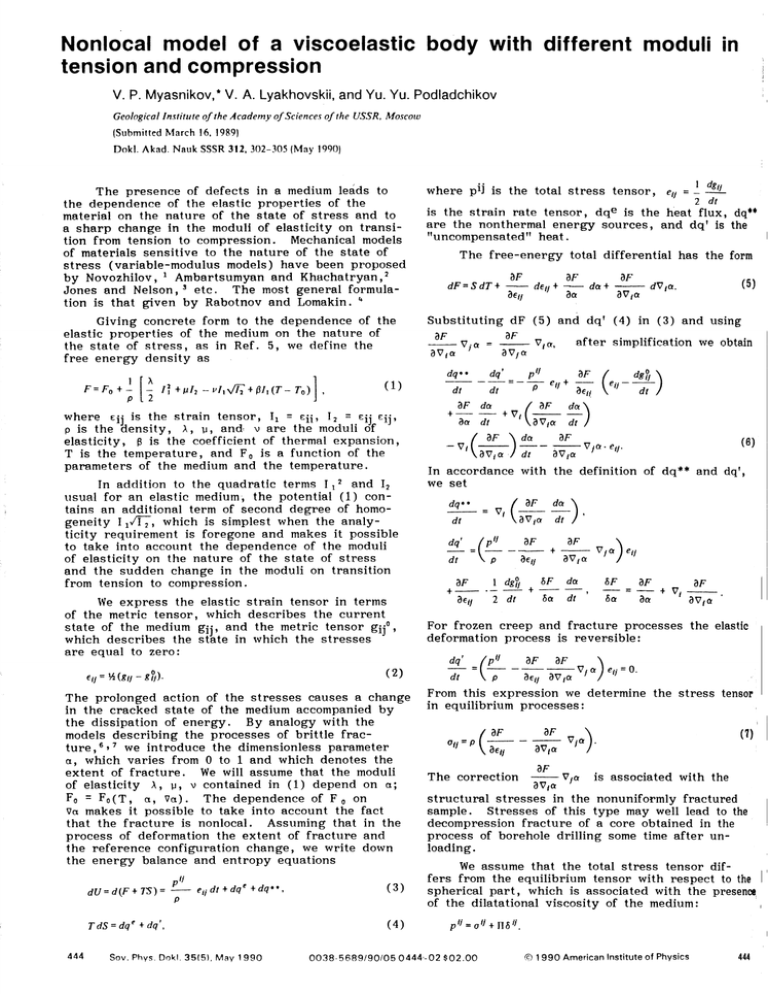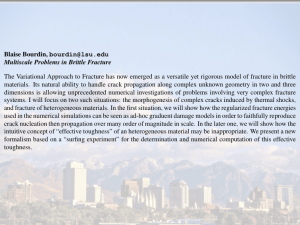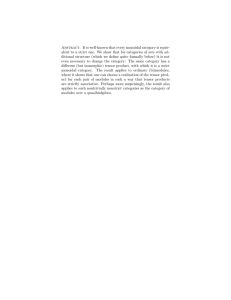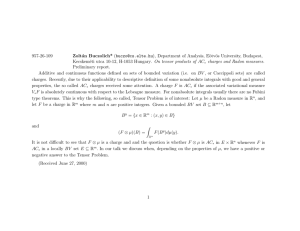Nonlocal model of a viscoelastic ... tension and compression
advertisement

Nonlocal model of a viscoelastic body with different moduli in tension and compression V. P. Myasnikov,* V. A. Lyakhovskii, and Yu. Yu. Podladchikov Geological Insrirrrre of rhe Academy of Sciencer of the USSR, Moscoru (Submitted March 16. 1989) Dokl. Akad. Nar~kSSSR 312, 302-305 ( M a y 1990) The presence of defects in a medium leads to the d ~ p e n d e n c eof the plastic properties of the material on the nature of the state of s t r e s s and to a s h a r p change in the moduli of elasticity on transition from tension to compression. Mechanical models of materials sensitive to the nature of the state of s t r e s s (variable-modulus models) have been proposed by Novozhilov, Ambartsumyan and Khachatryan,' Jones and Nelson, e t c . The most general formulation is that given by Rabotnov and Lomakin. " Giving concrete form to the dependence of the elastic properties of the medium on the n ~ t u r eof the state of s t r e s s , as in Ref. 5 , we define the free energy density as where ~ i isj the strain tensor, I, = ~ i i ,I 2 = "ij 'ij9 p is the density, A , 11, and v a r e the moduli of elasticity, B is the coefficient of thermal expansion, T is the temperature, and F, is a function of the parameters of the medium and the temperature. In addition to the quadratic terms I ,, and I, usual for an elastic medium, the potential ( I ) contains an additional term of second degree of homogeneity I ,Jf;,which is simplest when the analyticity requirement is foregone and makes it possible to take into account the dependence of the moduli of elasticity on the nature of the state of stress and the sudden change in the moduli on transition from tension to compression. We express the elastic strain tensor in terms of the metric tensor, which describes the current state of the medium gij, and the metric tensor gijO, which describes the state in which the stresses are equal to zero: The prolonged action of the stresses causes a change in the cracked state of the medium accompanied by the dissipation of energy. By analogy with the models describing the processes of brittle fract u r e , 9 ' we introduce the dimensionless parameter a , which varies from 0 to 1 and which denotes the extent of fracture. We will assume that the moduli of elasticity A , v , v contained in ( 1 ) depend on a ; Fo = F o ( T , a , Vn) . The dependence of F , on Va makes it possible to take into account the fact that the fracture is nonlocal. Assuming that in the process of deformation the extent of fracture and the reference configuration change, we write down the energy balance and entropy equations 444 Sov. Phvs Dokl 35(51, May 1 9 9 0 dgli where pij is the total stress tensor, ell = -1 -2 dl is the strain rate tensor, dqe is the heat flux, dq2* a r e the nonthermal energy sources, and dq' is the "uncompensated" heat. The free-energy total differential has the form Substituting dF ( 5 ) and dq' (4) in (3) and using - -- v f a , al; al; -Via avla after simplification we obtain av,a In accordance with the definition of dq** and dq', we set For frozen creep and fracture processes the elastic deformation process is reversible: From this expression we determine the stress tensor in equilibrium processes : a~ ~ f j = 1 al; p -( The correction ~ aF .iff). -V i a av,a is associated with the structural stresses in the nonuniformly fractured sample. Stresses of this type may well lead to the decompression fracture of a core obtained in the process of borehole drilling some time after unloading. We assume that the total stress tensor differs from the equilibrium tensor with respect to the spherical p a r t , which is associated with the presence of the dilatational viscosity of the medium: 0038-5889190105 0444.-02 $02.00 @ 1 9 9 0 American Institute of Physics 444 1 I Substituting the expression for dq' in ( 4 ) and introducing the unit mass heat flux vector q~ so as to give it divergence form (dqe = (-l/p)div q ~ d t ) , for the entropy production Q we obtain Here and in what follows it is assumed that d g n n o / dt = 0. In order to ensure the nonnegativity of Q, we use linear phenomenological relations which, in accordance with the Curie principle, l o relate quantities with the same tensor dimension: FIG. 1 ture kinetics determine the characteristic time scale, which depends on the load. If the kinetics a r e sloy relative to the volume s t r e s s relaxation time ( a / a >> q , / k , k is the compressiblity), the rate of change of volume strain may be assumed equal to zero ( E = 0) and the dissipative potential (11) may be assumed convex when a < 1. The equilibrium stress tensor is able to establish itself in the medium. In this case the maximum permissible a for which the potential (1) preserves its convexity (ae) will depend on the type of loading C (Fig. 1 ) . An increase in load will lead to an increase in the fracture rate. At loads that ensure the satisfaction of the condition a/; << q , / k the volume stresses a r e unable to relax in the characteristic time determined by the fracture kinetics. The elastic volume strain can be assumed equal to zero ( I , = 0 ) and potential (1) can be assumed convex when a < 1. In this case the quantity E , I K is determined by the type of loading. The potential (11) is convex when a < av (Fig. 1 ) . For a load with I;, < I; < t,, , irrespective of its magnitude, a brittle fracture process is realized [potential (1) loses its convexity]. When t, < I;,, the extent of fracture does not increase, and the deformation is associated with viscous flow (creep). When I; > c 2 , depending on the magnitude of the load, either brittle o r ductile fracture may be realized [potential (11) loses its convexity]. In the case of incompressibility and no dilatational viscosity, the model medium is equivalent to a linearly viscoelastic medium with viscosity that depends on the extent of fracture. , In order to ensure the nonnegativity of the last term in the expression for Q, we assume B y analogy with ( I ) , in order to take into account the dependence of the creep on the type of loading, we specify the positive-definite dissipative potential of second degree of homogeneity 4 in the form In accordance with the relations we obtained, the internal energy balance equation takes the form In order to obtain a closed system of equations, to relations (7)-(12) we must add the continuity condition and the equilibrium equation. Before determining the specific form of the dependence of the parameters of the medium on a we will establish certain constraints. We assume that in the state a = 0 the model medium is linearly elastic ( v = 0, rl, = 0). In the state a = 1 the medium is completely fractured, i . e . , stresses leading to a n increase in volume cannot be created in the medium. This can be ensured by assuming that when a = 1, the potentials (1) and (11) cease to be convex when I, > 0, E, > 0. For the convexity of potentials (1) and (11) i t is necessary and sufficient that all the eigenvalues of the matrices d 2 F / d ~ i j dEij and d l ~ l d e i j d e i jbe positive, from which it follows Uiat Worresponding Member, Academy of Sciences of the USSR. 'V. ' ' By specifying a particular, s a y , linear form of the dependence of the parameters of the medium of the extent of fracture, it is possible to carry out an analysis of the limit state in which one of the two potentials loses its convexity. The frac- 446 Sov. Phys. Dokl. 3 5 ( 5 ) ,May 1990 s, V. Novozhilov, Prikl. Hat. Mekh. 183 (1951). S. A. Ambartsumyan and A. A. lolachatryan, Inzh. Zh. Mekh. Tverd. Tela, No. 2, 18 (1966). R. M. Jones and D. A. Nelson, A I M J . 14, No. 10, 62 (1976). E. V. Lomakin and Yu. N. Rabotnov, Izv. AN SSSR, Mekh. Tverd. Tela, No. 6, 29 (1978). V. A. Lyakhovskii and V. P. Myasnikov, Izv. AN SSSR, Fiz. Zemli, No. 10, 71 (1984). Yu. N. Rabotnov, Mechanics of a Deformable Solid [in Russian], Nauka, Moscow (1988). L. M. Kachanov, Fundamentals of Fracture Mechanics [in Russian], Nauka, Moscow (1974). L. I. Sedov, Continuum Mechanics [in Russian], Nauka, Moscow, Vol. 1 (1976). A. B. Roshchin and L. H. Truskinovskii, Prikl. Hat. Mekh. 53, 863 (1989). O S. de Groot and P. Hazur, Nonequilibrium Thermodynamics, North-Holland, Amsterdam (1962). "E. A. Kozlovskii (ed.), Kola Superdeep [in Russian], Nedra, Moscow (1984). - Translated by T . E . Burton Myasnikov et al.




